By any standards, July was not much of a fishing month. However, at the very end of June, regular angler PB from Churchdown with a friend managed one golden day at the upper Wye’s Craig Llyn. This was one of those sunshine and showers periods during which they experienced “a continuous hatch of olives throughout….” That’s the stuff we want, I thought on reading this: cloudy weather, a steady trickle of emerging flies and the fish rising confidently. It was the kind of fishing we all dream of and, using dry flies, between them they caught 18 trout to 18 inches and 27 grayling to 17 inches.
Meanwhile Merthyr Tydfil angler RG accounted for another half dozen trout from Llwyn On reservoir. Salmon fishing was still quiet, although on the first day of July JS from Aberdare lost one in the overhanging tree branches of Martins Pool at Symonds Yat, while Wyesham picked up a couple more two sea winter fish. Some very big catches of chub were being put together on the Wye at the same time along with a good few barbel, but JB from Purton with a friend were unhappy with just a brace of chub taken at Thomas Wood: “canoeists every 6/7 minutes…fishing pretty much pointless…WUF should make this clear…I wouldn’t have booked if I had known.” Well, there are certainly some problems about the Wye, which we can all hope to put right, but let us not have any illusions about the historic rights of navigation. The river is legally navigable up to Glasbury and during the summer canoes and other craft can be expected on the river in numbers. We make no apologies for that, but will certainly try to defend against the ongoing campaign to extend navigation to the upper river and tributaries or to the neighbouring Usk.
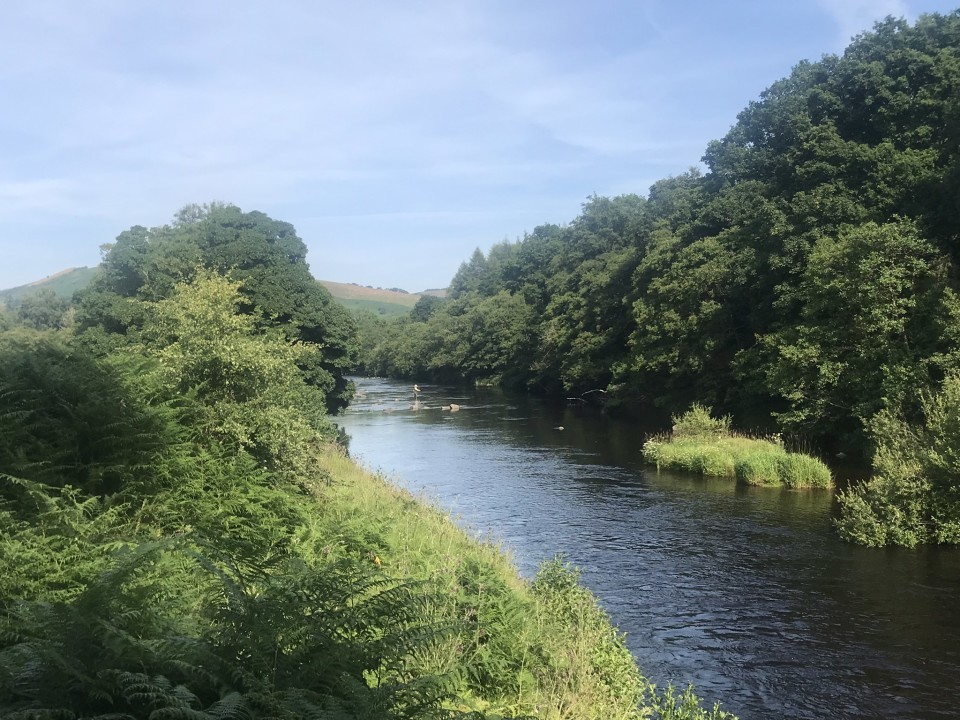 Craig LLyn - PY from Hereford
Craig LLyn - PY from Hereford Meanwhile RD from Woodford with a friend was fishing at Strangford (5 barbel and 65 chub) and they were almost certain they had seen a red squirrel. That’s rather wonderful if true. I can’t remember seeing a red squirrel in the UK.
During the first week of July, the weather became steadily warmer, the showers already mentioned hadn’t amounted to much, and although a number of anglers were out trying in our by now very much sunken rivers, the sport was becoming poor. Accordingly there were few significant reports. Wyesham continued to pick up the odd salmon from just above the tide. On the 6th PB from Churchdown with a friend fished the Carmarthen Amateurs water on the lower Towy until 2.30 in the morning. They didn’t catch a sewin but their account makes interesting reading. I did hear of a number of smaller sewin taken by night during the early part of the month. MH from Swansea took his nephew to Gromaine and Upper Llanstephan and they accounted for 10 trout and 3 grayling. Lake fishing slowed right down, although the dry fly would tempt a few.
David Burren and I fished the Wiltshire Avon at Heale House again on the 7th. Most of the weed cut was finished and mayfly were still hatching but we had to work very hard through a hot day. Trout were visibly rising to inspect the fly but dropping back, or taking in a very uncertain and diffident way to be missed or barely lip-hooked on the strike. This sort of thing can be quite frustrating: am I striking too early or too late? I spent some of the time on a carrier in the shade as well as on the main river and ended up with 6 trout and 4 grayling. Although the chalk streams with their deep springs are obviously running fuller and cooler than the rain-fed rivers nearer home, it was still necessary to be quite careful about catch and release, particularly with larger fish.
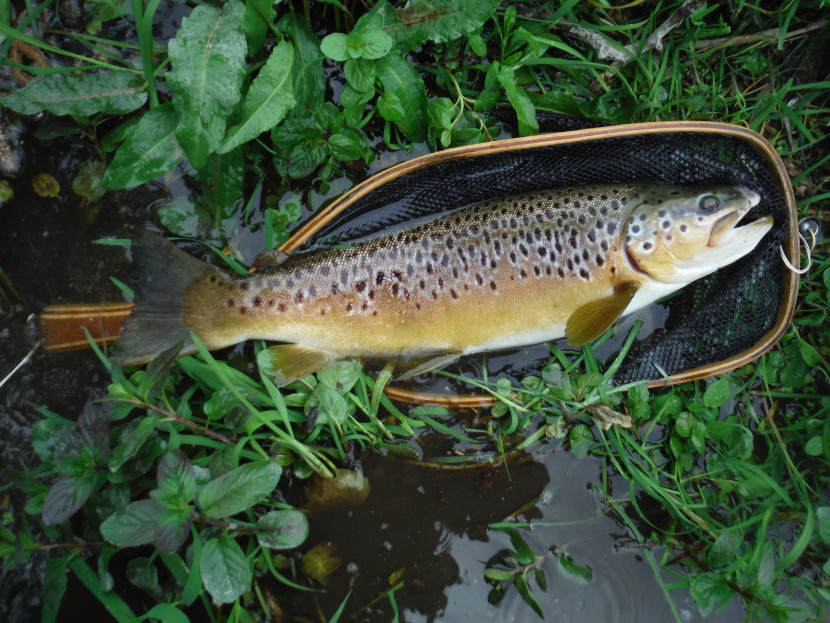 Avon brown trout
Avon brown trout 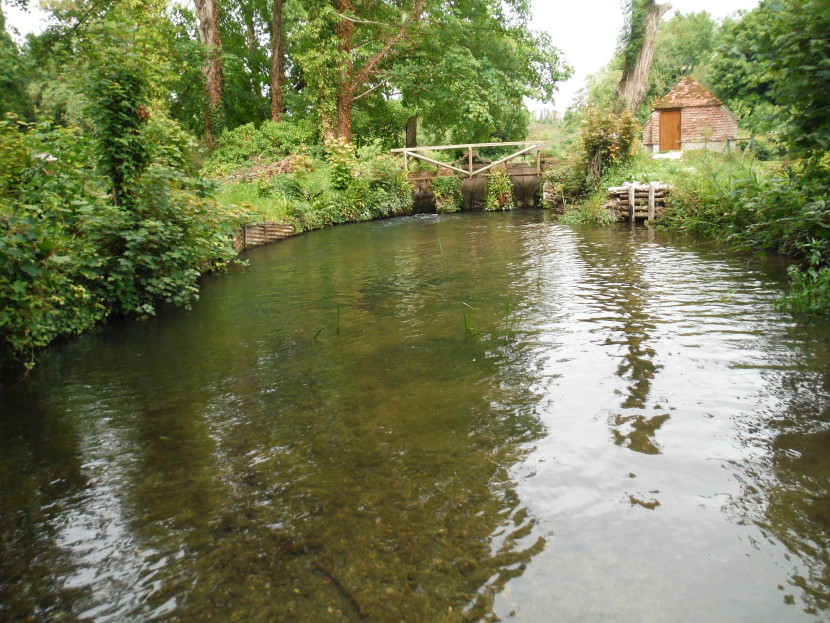 Avon carrier
Avon carrier On the 8th, with a growing heat-wave now under way, the WUF took a decision. Nobody likes closing the river, but in warm water a fish kill can occur quite quickly. On the Wye, water temperature at Glasbury was now up to 20 degrees, and 21 degrees further downstream. 18 degrees is generally considered to be the maximum temperature at which salmonids are safe and comfortable. Accordingly the WUF sent out a notice advising that in the interests of fish welfare salmon fishing should cease until the weather cools and it was already likely that further advisories would be sent for trout and grayling and coarse fish also. About the same time, the Gwent Angling Association advised their members to stop all fishing on their river fishing beats. Coarse fishing was closed by the WUF on Monday 11th followed by a decision to close the main Wye below Builth and the Usk below Brecon for all game fishing including brown trout and grayling. Merthyr Tydfil Angling Alliance also closed their Usk beats.
There had been moments of uncertainty about the Wye, which usually runs very slightly cooler than the Usk due to sources at higher altitudes and the arranged releases with Welsh Water from the Caban Coch dam in the Elan Valley complex. Additionally a couple of cooler days were predicted mid-week before another heat-wave weekend. However, thermometer readings taken on the 13th left the WUF with no other responsible choice. This still left most of the river above Builth, plus the tributaries and wild streams still open as waters which might benefit from shade; anglers were advised to take a temperature reading looking for 17 degrees or less, and make a responsible decision according to the results. Thus GM from Shrewsbury reported 8 trout and 6 grayling from Craig Llyn on the 13th. DC from Worcester had 14 trout and 11 grayling from the same beat on the 14th. The Towy, which benefits from cold water flowing under the Llyn Brianne dam, also remained open at this time. A few shoalies, fish to about 2.5 pounds, had already been taken on early July nights including several with the Surface Lure. About this time CT from Ammanford reported a couple of small sea trout from the Tawe’s number 2 beat, with larger salmon following the spinner. However, on Monday 18th the Llandeilo club decided to close their Towy waters for the week at least. The Pontardulais AA concluded that while small numbers of sewin were currently in the Loughor, they would benefit from being left in peace until after the heat subsided.
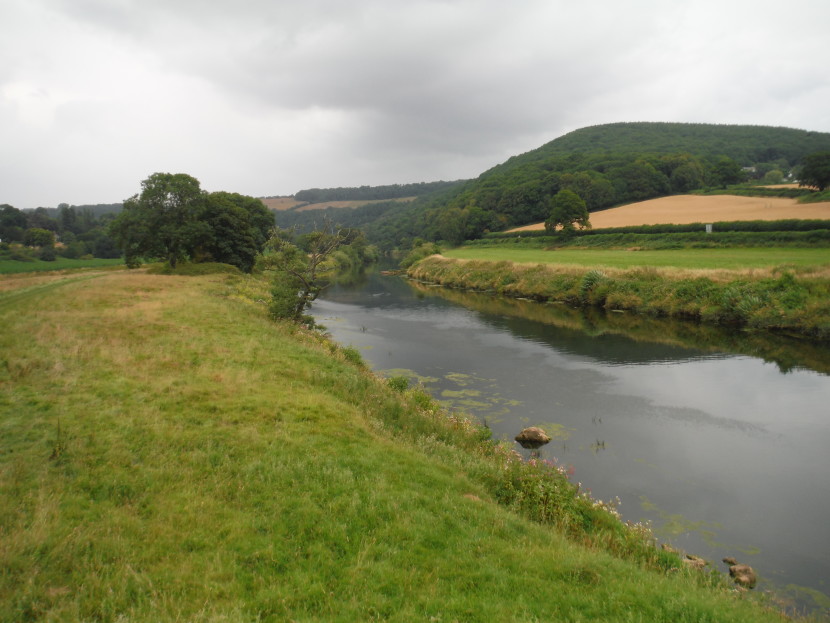 Bigsweir drought
Bigsweir drought 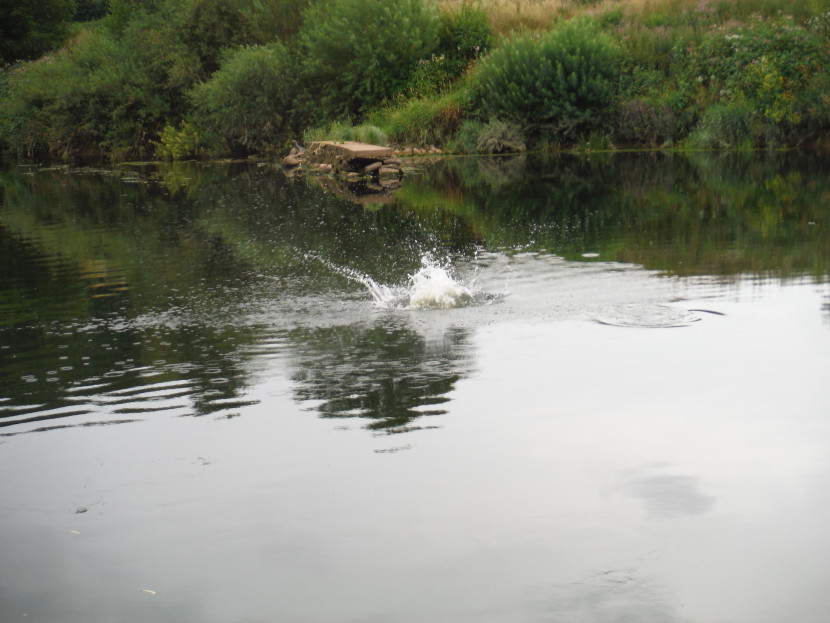 Hot and bothered - unhappy salmon
Hot and bothered - unhappy salmon Meanwhile, have some sympathy for the poor fish farmers in this kind of weather. At about this time I heard about a fish kill involving several hundred brown trout in a chalk stream stew affected just for a few hours by an intake grille temporarily obstructed by cut weed and other detritus. The fish were fine when fed in the morning; by early afternoon thousands of pounds worth of 12 inch trout had died in the sun.
Inevitably, the onset of what was predicted to be a record heatwave combined with many weeks of drought was now leaving our angling scene very quiet. I had a couple of days with clients at the Big Well commercial fishery at Redbrook, which famously benefits from cold upwelling springs. The water company utilise the springs during the day, but cool underground water runs through the four pools by night which keeps temperatures moderate and fish happy. Incidentally, for the same reason they never freeze over in winter. Big Well is an exceptional case; many other commercial rainbow trout fisheries are closed at this time of year or in these conditions. Again, those insisting on seeking wild fish despite the heat were best advised to look at the high mountain lakes or shaded pools at the top of the tributaries.
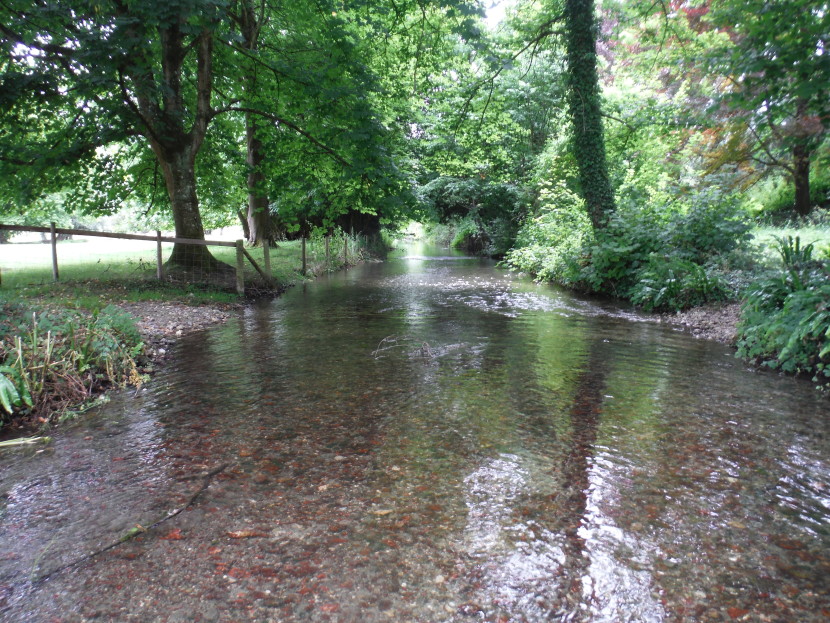 Fishing in the shade
Fishing in the shade 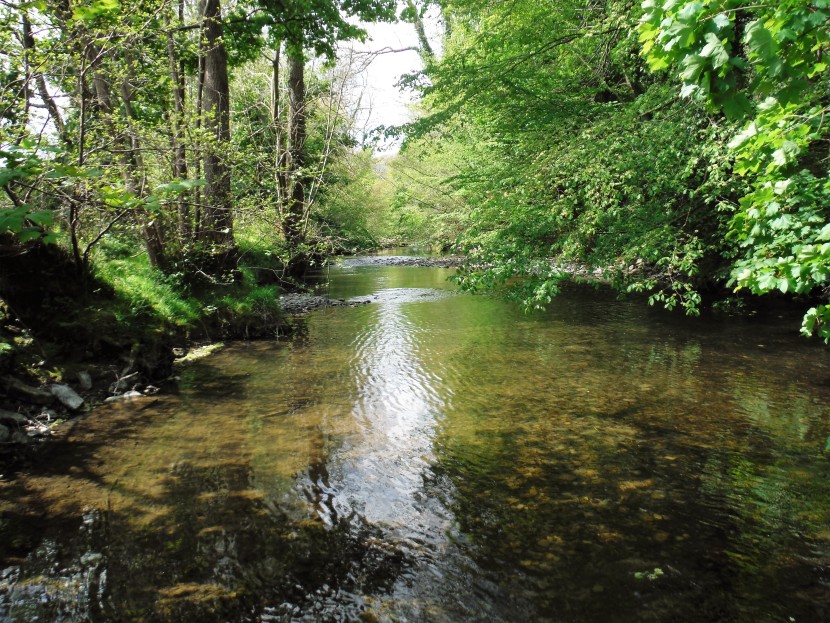 The Teme at Bucknell
The Teme at Bucknell By the 15th with a red weather warning now in place for central and southern England and record 40 degree air temperatures predicted early the following week, there were further real concerns about the Wye and its fish. The Foundation met with Natural Resources Wales and Welsh Water, and an agreement was made to release additional cool water into the Wye from the Elan Valley dams over a three day period at a rate of 640 million litres per day. This release started on Friday 15th and continued until midday on the Monday, in an attempt to push the warm water out of the lower river by the time the heat-wave reached its peak. At the same time, farmers on the lower reaches were requested to abstain from abstraction in order to allow the cooling flow to do its work. Arguably an abstraction ban should have been put in place, but the authorities contented themselves with a recommendation to hold off watering crops for a few days.
The 19th was the heat-wave peak, just as predicted, Heathrow Airport being the place where the English daytime record was broken at 40.2 degrees. The water temperature in the lower Wye reached the middle and high twenties. The heat was pretty unpleasant, but as you might expect there was a national debate about why British government institutions were making such a fuss about it all, given the fact that many other societies continue to function in such temperatures and indeed Britons are famous for rushing in high summer to the Africa-facing beaches of southern Europe at every opportunity. Sadly there were some wild fires and deaths from drowning while the hot weather was with us. Anglers, be it not forgotten, had a special problem along with local farmers and gardeners. Quite apart from the heat in the air, there was hardly any water in our rivers and streams, the rainfall having been so very low all spring and summer. The EA reported undertaking a fish rescue from the Redlake Brook, near Bucknell in South Shropshire. I imagine they would also be keeping a close eye on the nearby River Teme, which regularly suffers from low flows during the summer months. There were some other unusual events. Harbour porpoises were spotted in the Severn right up at Tewkesbury Weir, doubtless having followed vulnerable salmon up with the tides. Thanks to its ship canal, Gloucester on the Severn has a reputation for being Britain’s most inland salt water port, but I wonder has a cetacean, a real blowhole whale, ever before been recorded as far inland as Tewkesbury?
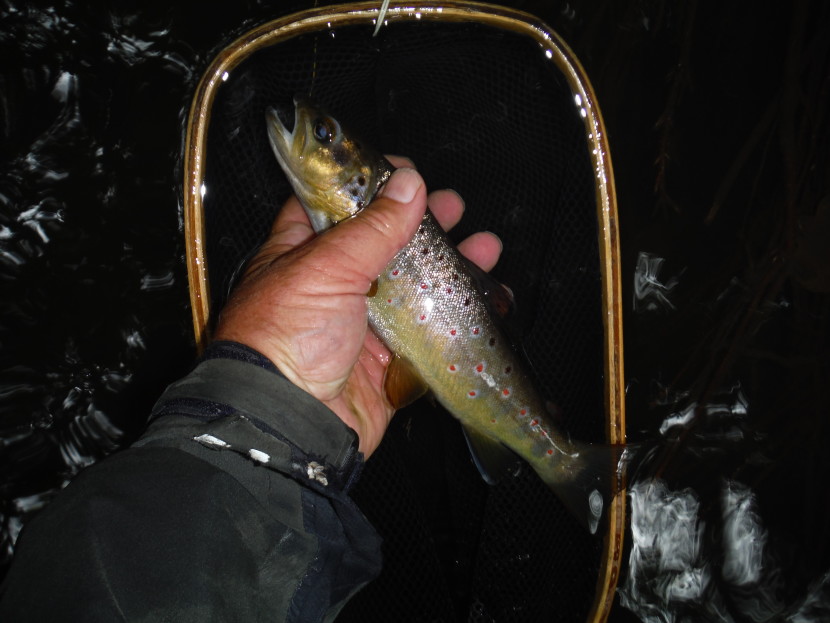 Bideford Brook2
Bideford Brook2 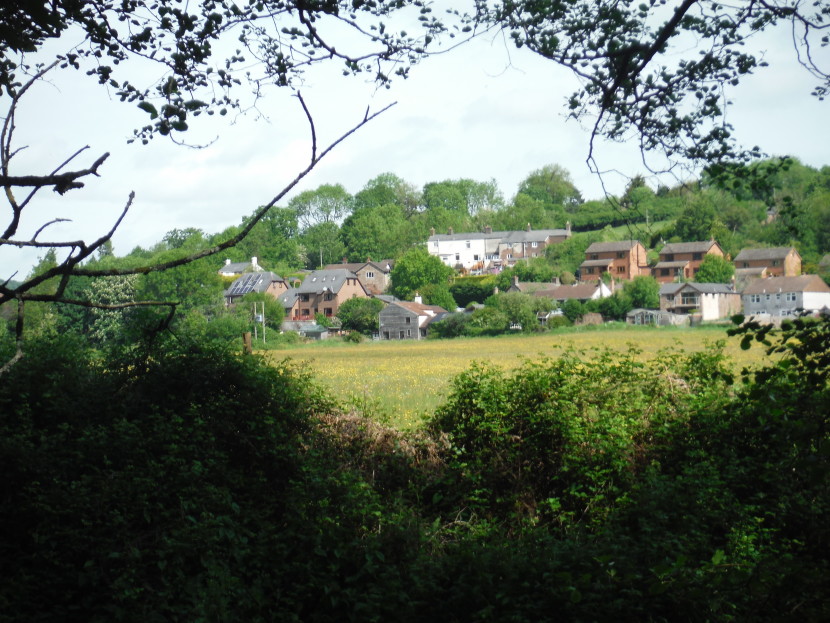 In the valley of Bideford Brook
In the valley of Bideford Brook By the 22nd we were in a quandary about what would happen next. The main rivers remained closed off from angling and the water levels as low, or lower, than anybody could remember. I saw parts of the river bed I have never seen before. Already accounts were coming in of dead salmon and also barbel in the lower river, according to social media seen in numbers below Monmouth, and also several more reliably reported from the Ross Angling waters higher up. The air temperature was very slightly lower now, helped by cloudy skies, but the trend over the next week or so was predicted to be upwards. The small streams also had become a sight for sore eyes. I did my regular bug count for the Riverfly project in the Bideford Brook and found the river watering an estimated 25% of the normal bed, just trickling between pools while the stones elsewhere were dry and bleached white in the sun. How many million caddis grubs must have died in their cases as the water receded? The Cannop Brook eventually ends in our local port, where it fills a deep canal, upper and lower yacht basin, before discharging into the salt water of the Severn. However when I looked on this occasion, it wasn’t discharging, the water in the basin remaining a foot below the sill of the overflow weir at the bottom. This was the first time I had seen the associated fish and elver passes leading up from the estuary completely dry. I can only assume that the slight incoming flow of the brook was not enough to keep up with either evaporation from the surface of the harbour, or with leakage through the lock gates. Some showers, even thunder storms were predicted, but there was no sign yet of the heavy and sustained rain needed to fill our rivers. The same afternoon I took a walk by the lower Wye at Bigsweir, where the river dragged painfully slowly between banks of duckweed. I saw no corpses. The pools were full of coloured salmon though, and every minute or two one of the great fish would throw itself out to fall back to the surface with a crash.
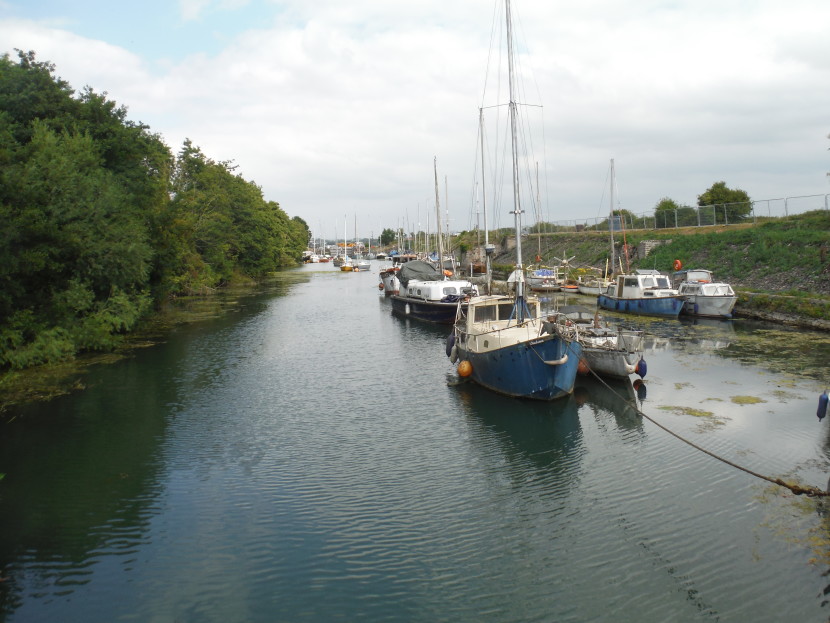 Cannop Brook at Lydney harbour
Cannop Brook at Lydney harbour 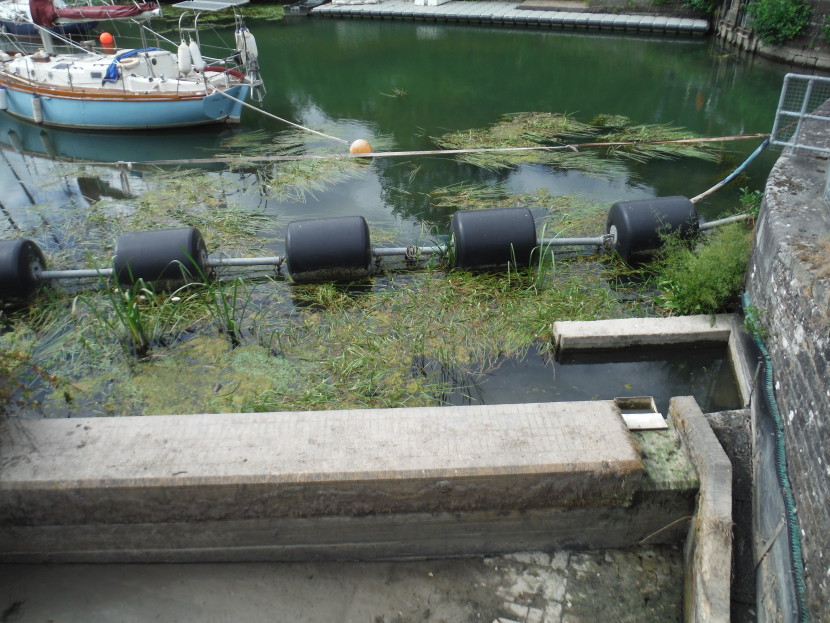 End of Cannop Broook and the harbour - no overflow
End of Cannop Broook and the harbour - no overflow The weather grew slightly cooler, mist and cloud drifted over our hills and there were occasional localised showers, some heavy for a brief period, but seemingly not enough to affect river levels. Then on the night of the 24th there was some intense rain in Central Wales which did look to have done some good; the Irfon gauge at Cilmery came up to 0.66 metres and the upper Wye came up a foot. With a flush of cool water on its way down, the WUF decided to re-open fishing of all kinds on both rivers.
We received now some reports about alternative kinds of fishing which had been tried during the hot weather. One which caught my eye was a classic report from an angler who had fished the Usk Reservoir during the heat of the 19th. I’m minded to quote the whole thing; after all it is only one sentence: “Absolute rubbish up there yet again sure there is poaching going on up there as I have been a few times now on different days and caught nothing I will not go up there again and waste £23.00 it is a right rip-off and if I go again I ain’t paying I repeat it is a massive rip-off.” I’m not quite clear from that whether this gentleman is planning to give up fishing the Usk Reservoir or to poach it himself: “…if I go again I ain’t paying…” The first course, I suggest, would be the best one. Other people fishing in the same difficult conditions caught the odd brown and rainbow trout and some perch. JD from Caldy with a friend had a difficult day on Llyn Bugeilyn, not at all helped by the fact that the padlock code on the access track gate had been changed without notice – a problem the WUF had to resolve on the day. I seem to remember that a couple of years ago, anglers had the same gate locked behind them while they were fishing. They had to lift the gate off the hinges to escape. Land owners really should be more careful!
TM from Somerset had 8 grayling and a trout from Craig Llyn on the 21st. GW from London had two really good days on the Raby Estate water of the River Tees, a very famous Northern fishery, beginning with 18 trout on the 23rd. On the following day he fished the top section from Widdy Brook to Cauldron Snout, and had 38 trout using a pair of Pheasant Tail Nymphs. Joe Alexander from Leominster visited his favourite Hundred House beat at the top of the Edw, checked the water temperature and found it a reasonable 14 degrees, before taking 7 trout on dry fly. CT from Cardiff tried something different at Pant y Llyn, taking a brace of its famous wild carp and a couple of chub.
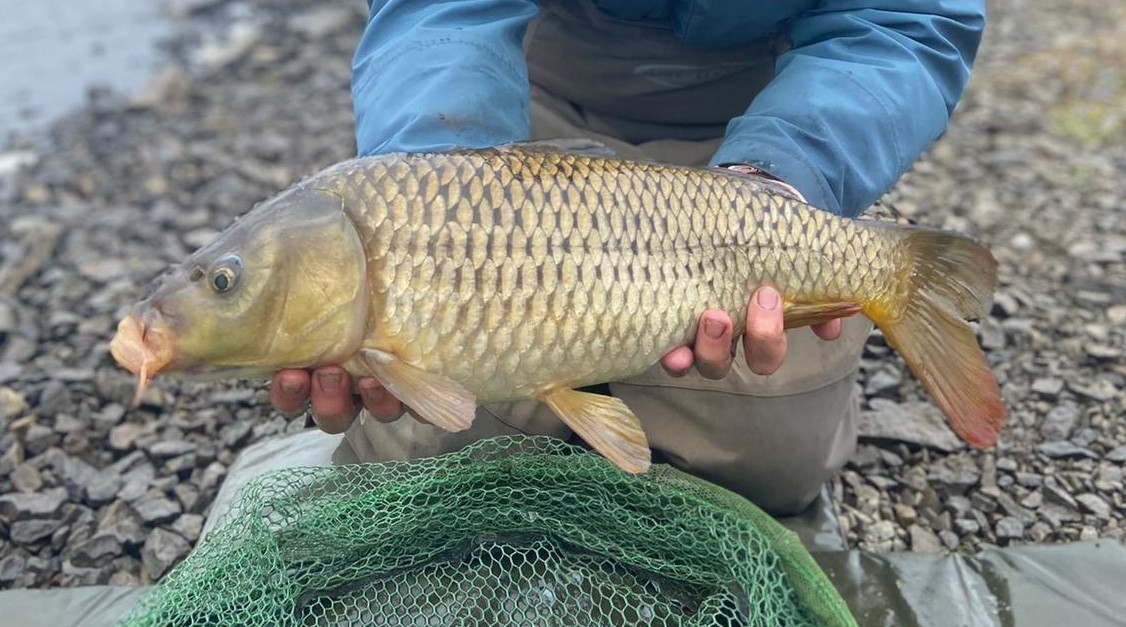 Pant y Llyn carp - CT from Cardiff
Pant y Llyn carp - CT from Cardiff Emlyn Rees of Cenarth, having been found guilty of spear-heading an extensive poaching operation which spanned 7 years and killed 989 sea trout and 302 salmon (he actually kept records), was fined 1,600 pounds and received a confiscation order for 61,791 pounds representing the value of the fish which he stole. As it turned out he has no assets and could not pay this, he was asked for a pound to be going on with, which he paid. He will be liable for the whole £63,391.50 when he acquires some assets. Whenever that may be. Am I missing something here, or would a prison sentence not be appropriate for such a case?
There are renewed worries about local angling in this corner of Gloucestershire. Forestry England have now revealed concerns raised by an engineering report about the dams on two forest lakes. These are the Cannop Ponds, upstream from the Wild Stream beat of the same name (and the reason why roach and perch are very occasionally found by trout anglers in that forest brook). These large adjoining ponds were built in about 1800 to supply the iron works in Parkend, and you can still trace the leat which fed the water along the contours of the valley just above the course of the later Victorian railway line. The tower-like building covered with ivy in Parkend originally contained the beam steam engine for the iron works; more recently it housed a forestry training college. Cannop Ponds are known for their pike, carp, bream and all the usual coarse species, and the fishing is currently leased to the Yorkley Angling Association. Perhaps more importantly, these and other ponds in the Forest are known for their beauty and busy with visitors almost every day of the year.
The press release from Forestry England is putting the matter to public consultation, and points out that repairing the dams is an expensive business, but that if no action is taken there might eventually be a catastrophic failure in a time of heavy rains which could flood the downstream villages of Parkend, Whitecroft, Lydney…and our little house near the outlet to the Severn, I suppose…along with local railway lines and roads. I will touch some wood now and remark that this possibility seems pretty remote to me, but the Forestry England statement goes on to express some enthusiasm for the cheap option of “re-wilding the area,” by which they mean just draining the ponds and leaving the valley floor as a sort of overgrown bog, eventually to be invaded by trees. I am pretty certain that the anglers of the Yorkley club will object to that idea, but even more likely is that the much larger number of people who like to visit the ponds, walk their dogs and have a cup of tea from the refreshment van there will be unhappy about it.
Let’s see what the reaction will be, but this matter illustrates a problem being replicated all over Britain, where old industrial ponds and water company reservoirs remain long after their original function has departed. Most of them are enjoyed and many fished, but it would be a very rare thing for a fishing club to possess the funds to repair a dam. On the other hand, a water company finds it a strain to carry out repairs on an unproductive asset, just for the sake of local anglers. Thus we lost the beautiful Upper Neuadd reservoir in the Beacons, the water having been run out to take pressure off the dam in the interests of safety. I think this case is rather different in that a long way back in the history of what was formerly the Forestry Commission, the organisation’s mandated purpose in the Dean was changed from mere timber production to include the provision of exercise and leisure facilities for the public. Most lakes, whether natural or not, and quite apart from angling interests, are regarded by the public as gems to be preserved and enjoyed. A lake is a beautiful thing and I can’t think of a landscape which would be improved by removing one. I must also remark that I’m getting a bit irritated by the current obsession with “rewilding.” There is money for it at the moment of course but some of the thinking involved seems remarkably woolly – and that might include the recent plan for bison on what I suppose will be the great plains of Kent. My wife, exasperated as many of us are with the problems caused by feral boar in the Forest, has stuck her tongue in her cheek and suggested introducing some Yugoslav bears and wolves to trim them down a bit. In a decade in Yugoslavia I never saw much more than the footprints of such interesting wild-life (although I was invited to shoot boar once), but my late father-in-law told me about the time he came across a bear by the road while driving his truck early one the morning in the Bosnian mountains. “What was it doing?” I wanted to know. “Eating a dead cow” was the reply. He drove on and left Bruin to his breakfast.
A newsletter from the EA informs that they will no longer be selling rod licences via post offices. That’s a pity. I know…I know…you can still get the licence on-line or over the telephone. It’s just always a pity when an organisation withdraws a service, for its own convenience rather than that of the customer. If the EA aren’t careful, they will become just as popular as the (formerly) high street banks are these days. Some people, be it known, still like to do transactions with a friendly face at the post office.
Here is a historical curiosity. The August edition of Fly Fishing and Flying Tying carries a slightly confused and confusing article by Charles Jardine about a down and across wet fly known as the Usk Nailer. I remember the late Stuart Jarvis used to carry this fly along with his own Grouse and Gold and Grouse and Silver. I still have this obvious olive imitator in one of my spring boxes and I used to use it a lot in early season or high water. The colours and materials are reminiscent of Oliver Kite’s Imperial dry fly – although in fact the Nailer would have predated that. I like it, but truth to tell I don’t know that it is actually better at the olive imitating job than a Waterhen Bloa. You sometimes see it referred to as the Usk Naylor, which is perhaps how the confusion arises and it is associated with the Worcester Cottages beat of the upper middle river.
 Usk Nailer
Usk Nailer Moc Morgan had it in his Trout and Salmon Flies of Wales, yet uncharacteristically Courtney Williams seems to have missed it from his Dictionary. My old friend Roger Smith made sure to include it in Flyfishing the Welsh Borderlands, in his case describing it as the Naylor. After a talk with Jean Williams of Sweets Tackle Shop, surely the best authority remaining, I think I may have got to the truth of it. The fly was invented during the 1950s as a collaboration between an angler Mr P Naylor and Gordon Price, the gillie at Worcester Cottages. Nailer was in fact the name they gave their new creation, which was also regularly tied for customers by Leslie Peters of Brecon. Here is the dressing:
Hook; Wet fly, 12 or 14
Tying silk: Purple
Tail: Blue dun
Rib: Gold wire
Body: Five strands of well-marked bronze mallard
Hackle: Blue dun
Like all the good ones, it’s a simple fly to make. Leave a little purple thread showing between the turns of mallard and also at the head. Some will insist on Andalusian dun for the hackle, but you will have your work cut out finding that.
Meanwhile, the August edition of Trout and Salmon carried a series of articles celebrating 150 years of the Hardy tackle manufacturing company. I only own the one Hardy rod, although quite a few Greys. However, I was intrigued and slightly flattered by the interviews with the reel making engineers, who were asked to declare their favourite model. Designer Steven Harper opted for the Bougle, light-weight version of the Model Perfect, which was added to the range in 1903. I am lucky enough to have a Bougle myself. It is loaded with a 4 weight double taper line for dry fly fishing on a 9 foot rod, and there is nothing about it I would change. It is a delight every time I use it, particularly that buzzing sound from the check mechanism when a fish makes a run.
Engineer Charlie Norris cited the Hardy Angel as one of the company’s best modern designs. I’m a proud owner of an Angel too, in my case the smallest “feather weight” version of the range loaded with a 3 weight double taper line for brook fishing. People always notice the check adjuster on the back of the Angel, which looks rather like an old-fashioned telephone dial. Neither of these reels have large arbours; does this lack not result in unwanted coils and kinks developing in the fly-line you might ask? Well, certainly not if you use a Cortlands 444 line, which is totally limp, almost like a silk line. Similarly, is it not a disadvantage when playing a big fish to be relying on a click check rather than a full adjustable drag system? Again, not in my experience. It’s easy to add additional drag on a running fish with the Bougle by judiciously using a finger to press onto the spinning line pack through the back. According to the engineers at Hardy, it takes 6-8 weeks to make one of their classic reels, going through all the processes in batches.
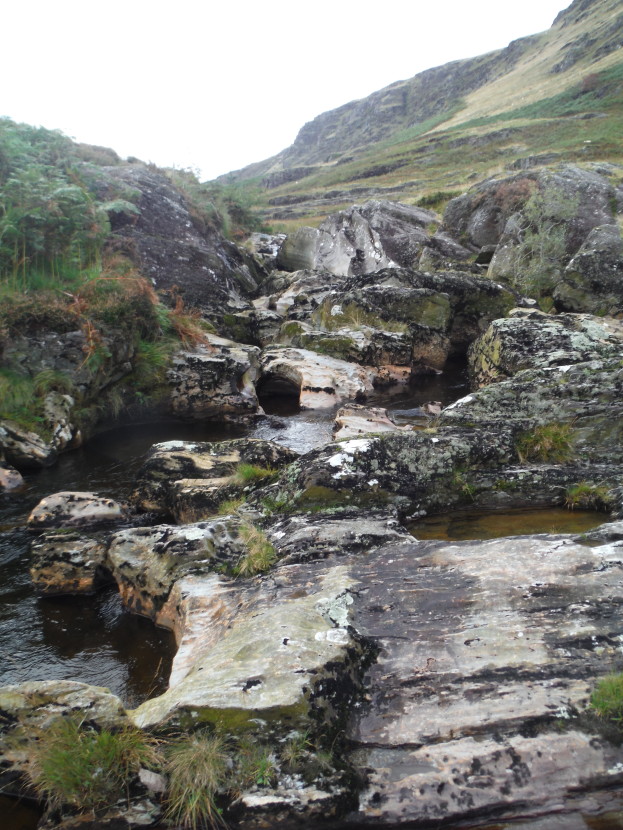 Abergeswyn at the very top of the Irfon
Abergeswyn at the very top of the Irfon Well, they brought him down at last. The long campaign of personal attacks finally produced such a fit of hysteria in the parliamentary Conservative party that, despite having an 80 seat majority and being half way through a term, they threw the captain of the ship overboard. Next morning, there was that sort of slightly bewildered atmosphere which prevails on waking up with a hangover while wondering exactly what it was you did last night, what on earth were you thinking of, and what the consequences might turn out to be? Not for long, though. Political journalists at the editorial offices of mainstream media outlets were already celebrating, could hardly believe their luck. Soon the feeding frenzy started with would-be candidates for the Conservative leadership ringing around for support and throwing hats into the ring. A Labour-supporting friend of mine at the shooting club on the Sunday morning confessed that he was having such a good time watching all the Conservative chaos that he could hardly stop chuckling. He was certainly in a buoyant mood.
It’s a bit early for eulogies while writing a couple of days after the defenestration, but I will remember Boris Johnson as the most honest politician of his generation. By that I mean that he kept faith with the expressed democratic wish of Britons and made the best job he could of giving them the Brexit which they had voted for. Others in politics and the civil service had already promised to do the same thing, but then worked hard under cover to do the opposite. This was a spectacularly dishonest time, even by the standards of British politics, but Boris tried very hard to keep his promises. In addition he made as good a job of managing the pandemic as anybody else might have done, given the advice he was receiving. The vaccine roll-out was a success by any standards; levelling up is a great idea although much more remains to be done. It seemed to me that Boris got most of the big decisions right. He had much more left to do: Northern Ireland’s status remains a problem demanding resolution, as do our nation’s border controls. He may have been too ambitious with the green agenda and I do have my doubts about the Ukraine policy. All these matters are important, perhaps important enough in themselves to bring a political leader down if mishandled, but was “Partygate” - or rather was it “Pinchgate” in the end - really important enough? A friend from Sweden sent a message with Pinchgate in mind after it was over: “What is it with you Brits, always having sex scandals in your politics? We don’t have sex scandals; we just have sex. And then we keep quiet about it” I shall miss Boris; he made me laugh and I liked his style. Who will forget him in Mayor of London days reciting the Iliad in ancient Greek on television, and at considerable length too? At the time of writing it’s 13th July and I suppose we should get on with the elections. For myself, if it has to be the B team, I’m rooting for Penny Mordaunt or Suella Braverman. Clearly we can’t have Rishi Sunak who is surely too small for the job? I refuse to have a British Prime Minister who can be looked down upon by Emanuel Macron. By the time you read this, you will know how all that worked out and probably be able to have a chuckle at my expense.
I hate wearing a tie. Sometimes you have to though, and so it was that suited and booted to a semi-respectable appearance I watched a commendations award ceremony on an army base in Staffordshire this month. It was a very happy day for our family and actually quite a relaxed event. No drawn swords or saluting on the square, but during the chat over coffee afterwards there was a fair amount of gold braid among the smart summer dresses. One thing was clear from the conversation: the absolute confidence of the British military that Russia can be confronted and faced down. I didn’t want to rain on anybody’s parade with oppositional remarks over coffee cups, but this position is official and it’s everywhere in the Army today. There is a strategy speech posted online by Sir Patrick Sanders who has just been appointed Chief of the General Staff, emphasizing a preparedness to fight in Europe and defeat Russia in battle if need be. The determination behind this strategy outline is unmistakable. General Sanders surely knows what we are up against and does concede the somewhat daunting truth that Russia has a history of beginning wars badly, but finishing them rather well. Right now Russia is grinding through the Donbas town by town, has a large slice of the world’s wheat supply blockaded in Black Sea ports, and is holding the world to ransom with high fuel and gas prices. We can talk about trying to move some wheat up the Danube into central Europe, about trying to get through the coming winter with rationed energy, about supplying even more weapons to the Ukrainian military, but who seems to be holding most of the cards at the moment? And what do we believe Putin’s ultimate aim is? If, as some claim, he dreams of taking over all of Eastern Europe with its diverse populations, we have no choice but to oppose him. If he is aiming for what he asked for, the Russian-speaking areas of the Ukraine, he is almost there.
“What’s left on your bucket list?” It’s a question younger clients often ask me during the day. They often seem slightly disappointed to learn that I am not so anxious to jump on airplanes again, and that I am really quite happy now with the times I have had, and still hope to have, on our local border rivers. And then, mainly to reassure them, I think back and confess that, yes, it would be something to trek out to the far end of South America and catch one or two of those fabled giant sea trout, however hard the winds might blow round the open plains at the end of the world. I don’t suppose I will ever do it, but Argentine steaks with red wine in the lodge might be nice to finish the day too. And then I come up with something I really would like to do, practical and nearer home at that. “Did you ever hear of Malham Tarn?” I ask them.
Malham Tarn along with Malham Cove in the Yorkshire Dales is something quite rare, although there are other examples in the UK. It’s a natural limestone lake formed by a glacial moraine. When the end of a glacier corresponds with an outcrop of limestone, you tend to get the same result when the ice retreats: a semi-circular amphitheatre of cliffs and below areas of clear water with a very alkaline content blocked by a jumble of rocks. As such, the Tarn, which is quite shallow and 1200 feet above sea level, has some very rare plants, and is also very good for aquatic insects, particularly upwinged flies. It is therefore equally good, as you might imagine, for brown trout. Spawning opportunities are limited, so the trout, although not numerous, tend to run large. If you get anything, it’s quite likely to be a 5 pounder.
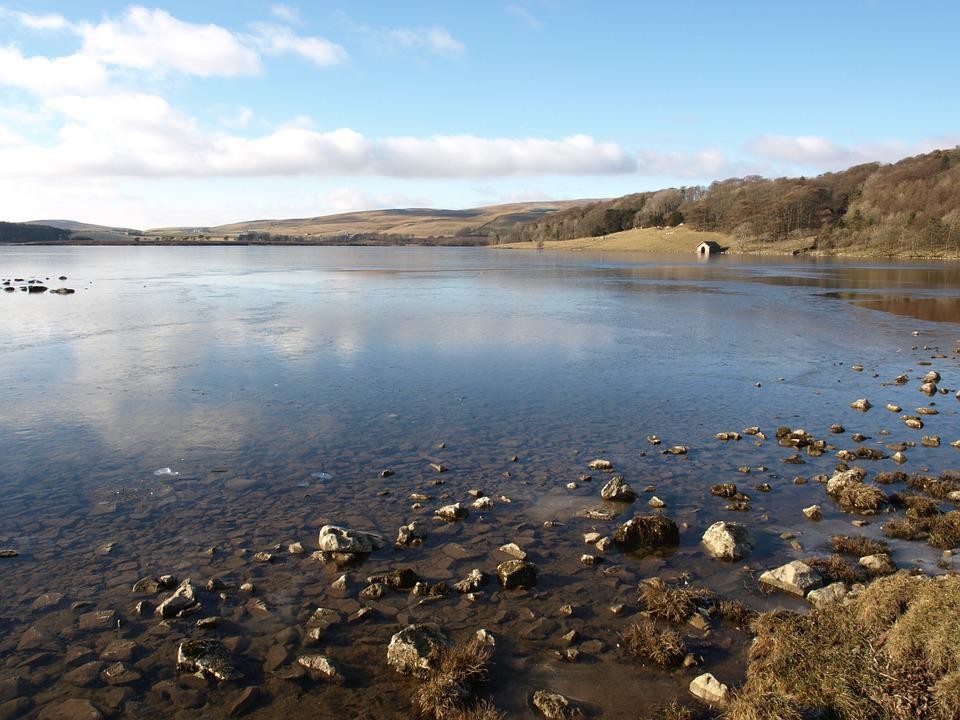 Malham Tarn
Malham Tarn Malham Tarn belongs to the National Trust, an organisation which is understandably anxious to defend this most unusual lake against invasive species. Access has always therefore been quite restricted. Anglers used to be accommodated if they applied via the Field Studies Council, but only by prior arrangement, fishing by boat and with no landing permitted. Traditional wet flies seemed to be the order of the day. I remember the late Chris Dawn, then editor of Trout Fisherman, telling me about the magnificent five pounds specimen he caught there with a Hatching Olive on the dropper.
For the last two years Malham Tarn has been closed to angling, partly due to redundancies at the Field Studies Council which may be linked to the recent pandemic, and partly due to concerns raised by a recent field study about threats to biodiversity caused by visitors. Accordingly, the National Trust has invited bids or applications from groups interested in running the fishery who will be able to meet the biological security requirements. I do hope somebody is minded to take it on; that is one British fishery which I would like to experience.
I think the only advice I can give during these very difficult times is “pray for rain,” after which we will probably get some tight lines!
Oliver Burch